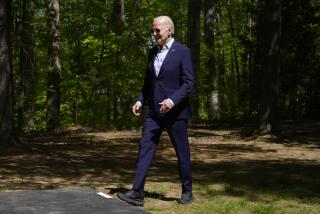Protesters, German police prepare for G-8 summit
The tear gas is stocked and the police are helmeted and ready for tens of thousands of anarchists and anti-globalization protesters who are planning rallies and guerrilla-inspired mischief to disrupt the upcoming Group of 8 summit in this Baltic Sea resort.
President Bush and leaders of seven other industrialized nations will discuss global dilemmas in a spa, while far away, beyond eight miles of razor wire and 4,800 concrete barricades, police and radicals will try to outwit and overpower one another amid flares, placards and water cannons.
It is a periodic showdown between leftists and cops, a rolling mosh pit of eco-warriors and anti-capitalists complete with hundreds of arrests, stinging eyes and occasional bloodshed. Germany has called up 17,000 police officers and soldiers to maintain order at rallies in several cities.
The events will include a march Saturday expected to draw 100,000 protesters to Rostock in what has been billed as a warm-up for the three-day G-8 meeting beginning Wednesday.
“We are afraid this demonstration will also turn violent,” said Konrad Freiberg, head of Germany’s police union.
The mood has intensified the debate in Germany over the security tactics of Interior Minister Wolfgang Schaeuble, a conservative accused by liberals of jeopardizing constitutional rights in his hunt for Islamist terrorists.
Taking ‘scent samples’
Schaeuble is moving just as strongly against activists heading to the G-8: Security forces recently raided the offices of left-wing militants, and police have acknowledged that “scent samples” were lifted from dozens of radicals so they could be tracked by dogs during protests.
The practice is reminiscent of the former East German communist secret police, known as the Stasi. Schaeuble has remained undeterred by the comparison; he has a measure of political capital after Germany’s security success as host of a peaceful soccer World Cup in 2006. This has prompted him and other officials to mobilize the army, something rarely done inside Germany since the Nazi era, and to bypass the European Union’s loose travel restrictions by tightening border controls this week to prevent “troublemakers” from entering the country.
Tension around G-8 summits has grown since the 2001 meeting in Genoa, Italy, when police shot and killed an anarchist and scores were injured in clashes. The coalition government of German Chancellor Angela Merkel, fearful of images of chaos in the streets but also sympathetic with ecological and other concerns raised by protesters, is navigating between protecting freedom of expression and expanding police powers.
Petra Pau, a member of the opposition Left Party, has criticized the government for what she described as heavy-handed measures. She said the scent samples were another indication that Germany was stepping “away from a democratic state of law toward a preventive security state.”
“A state that adopts the methods of the East German Stasi robs itself of every ... legitimacy.”
The peaceful protests and the guerrilla campaign of hard-liners already have begun. BMWs, Mercedes-Benzes and other luxury cars recently have been set ablaze in Berlin, along with vehicles belonging to the national energy supplier, Vattenfall, and the rail system. Police and protesters clashed Monday in Hamburg after a demonstration against the environmental and economic policies of rich countries.
A history of radicals
Germany has a colorful history of anarchists and leftist radicals, including the Red Army Faction, which in the 1970s and ‘80s assassinated a number of government officials and industrialists. Much of the scene is less volatile these days, consisting mainly of intellectuals, punks, squatters and environmentalists pushing for fair international trade, debt relief for Third World nations and climate control.
“I can’t accept that eight leaders meet here and decide about the rest of the world without any democratic legitimacy,” said Martin Meckel, a cleanshaven man with dreadlocks camped with about 35 others in a field beyond the concrete barricades and razor wire. “Those who are most affected by [the leaders’] decisions don’t sit at their table: the developing countries.”
The protesters’ target is the Heiligendamm resort and castle along an otherwise placid Baltic coast dotted with navy divers searching for bombs and militants in the surf. The spa was once popular with Italian dictator Benito Mussolini and German romantic poet Rainer Maria Rilke. But demonstrators aren’t likely to get within two miles of the resort unless a last-minute court decision grants closer access.
Bernd Fischer, head of the local regional tourism association, said the summit is a gift.
“All of a sudden a region that never gets into the news, not even with the most expensive media campaign, becomes famous,” he said, adding that hotel bookings have doubled, with much of the increase due to those attending.
“The fence is a sight. People are curious. They want to see it.”
The political buzz and flow of traffic has intrigued Fischer. The other day, he ventured near the fence with a stopwatch. He started counting passersby.
“Three thousand five hundred in an hour,” he said. “No kidding.”
*
Retzlaff reported from Heiligendamm and Fleishman from Berlin.
More to Read
Start your day right
Sign up for Essential California for news, features and recommendations from the L.A. Times and beyond in your inbox six days a week.
You may occasionally receive promotional content from the Los Angeles Times.







